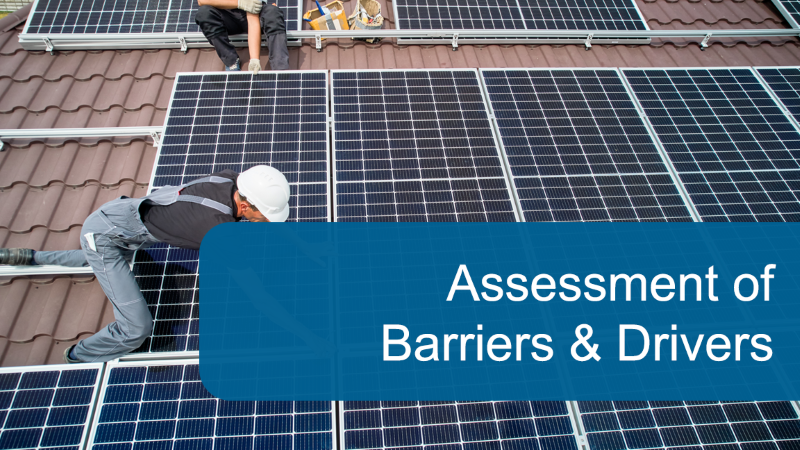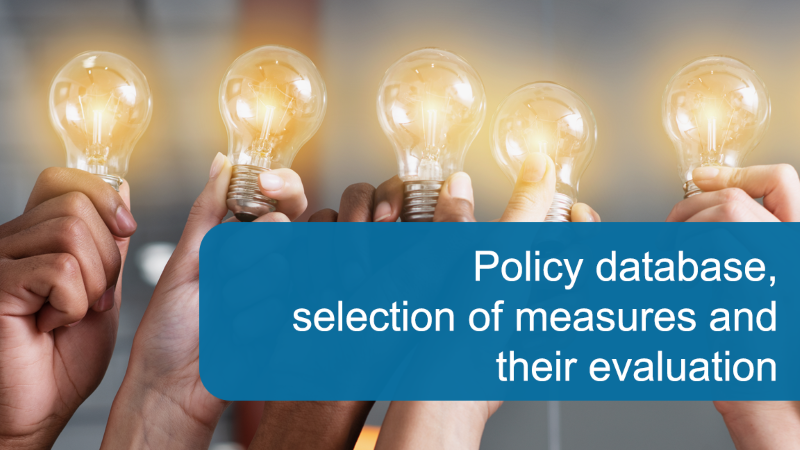Model Assessment Tool
What is the Model Assessment?
The Model Assessment is meant to be a tool to help national actors – mainly public authorities and civil society organisations – better assess potential for development of Renewable Energy Communities (RECs), as well as barriers that might hinder their growth.
Context
According to Article 22 Paragraph 3 of the recast Renewable Energy Directive (RED II), all EU Member States must carry out a national assessment of barriers for and potential of RECs in their countries. Ideally, Member States would use these assessments in order to develop concrete measures and policies to fill out their enabling frameworks for RECs.
While a few of these assessments have been carried out, energy communities are new in many Member States, and little guidance has been provided on how to undertake such an assessment. To fill this gap, the ECOLOG Institute for Social-Ecological Research and Education has created a Model Assessment Tool to help guide the development of national assessments of potential and barriers for RECs.
How to use the model assessment?
The Model Assessment contains a number of documents that can help guide both Ministries and NGOs to conduct their own assessment, taking examples from other model assessments and literature on energy communities.
The Model Assessment Tool is based on a modular, or step-wise, approach. To account for these different steps, the Tool composed of a number of different documents.
- A Manual – the manual is a document that summarizes the assessment process, and each of the different steps
- A Checklist – the checklist is a document that contains leading questions that can help guide whoever is undertaking the assessment. These include both process questions, as well as issues to keep in mind for monitoring the development and implementation of enabling frameworks over time
- The Steps – Each step is described in the Manual. However, the Model Assessment Tool also includes Background papers for each of the steps in order to help guide the assessor through the entire process.
- Preparation – how to take initial steps in designing the assessment, including the process and the desired objectives or outcomes for the assessment.
- Barriers and Drivers – how to identify different motivations for developing energy communities, as well as how to assess the main barriers.
- Potential – how to model potential scenarios for the development of RECs at the national level over time
- Costs and Benefits – how to assess different environmental, energy system, economic and social impacts RECs have at the individual, community and societal level.
- Policy Measures – how to identify and settle on policy measures in order to help develop RECs in line an evaluation of objectives, drivers, and potential impacts.
- Monitoring and reporting - how to make sure the assessment process is not standalone, but a starting point for monitoring how enabling frameworks operate and may need to evolve over time.
An adaptive assessment method
We understand that there is no one-size fits all approach to assessing potential of energy communities at the national level. As such, the Model Assessment has been tailored both for Member States with an existing energy community sector and for Member States where RECs are only starting to emerge. It also takes account of the resources (e.g. financial, human, time) available to the actor undertaking the assessment. As such, it provides guidance for undertaking an assessment where resources may be lacking.
Manual & checklist
In its manual, ECOLOG describes the idea of a model assessment of potential and barriers to the development of renewable energy communities at the national level and its elements. Moreover, the manual includes links to all relevant materials.
In our model assessment checklist, you will find a step by step approach to carry out an assessment of the existing barriers and potential of development of renewable energy communities.
Step 1: Preparation of the assessment

This step involves considering and planning how the assessment will be carried out. The preparation of the assessment will be different depending on an existing understanding of RECs at the national level, the maturity of the energy community sector across different activities, the existence or non-existence of a monitoring system, as well as time and resources, among other things. It also includes factors like public participation, and methodology.
Step 2: Assessment of Barriers & Drivers

This step involves considering and planning how the assessment will be carried out. The preparation of the assessment will be different depending on an existing understanding of RECs at the national level, the maturity of the energy community sector across different activities, the existence or non-existence of a monitoring system, as well as time and resources, among other things. It also includes factors like public participation, and methodology.
Step 3: Assessment of the Potential

It is important to understand the overall potential for the growth of RECs, based on technical potential, drivers and barriers. This is important to determine the extent to which it is desirable to develop specific policy measures and to what extent. There are a number of approaches to modeling this information. The Tool provides an overview of these different approaches, as well as some examples of modelling that has already been carried out on energy communities.
Step 4: Evaluation of Costs & Benefits

An analysis of potential costs and benefits is needed to justify any policy intervention. Moreover, such an assessment of costs and benefits may help to evaluate the choice of different policy instruments. Normally, policy-makers get involved when they know that what they are supporting will have a positive impact. The Evidence base on the potential benefits and costs associated with energy communities is still quite small. The Tool provides information on how to identify and assess different types costs and benefits of activities and support to RECs. Ideally, once policy measures are chosen, they would be monitored based on their actual impact so they can be fed back into “known effects” of different policies or measures.
Step 5: Policy Database, Selection of Measures and Their Evaluation

Based on the their assessments, Member States must select policy measures to “enable” energy communities to play a role in the energy sector. Usually, measures to be chosen are developed in national policy discourses. Sometimes policy-makers take up instruments developed elsewhere and adapt them to their national contexts. Against this background, the goal of a “policy database” is to provide a list of different enabling policies for consideration by stakeholders, especially civil-society actors, public administrations and political decision-makers. Different stake-holders can use this list of policies or strategies as a basis for the proposal of measures, which can then be assessed in order to make a final selection.
Monitoring & reporting
Member States should select policy measures that help to overcome barriers and strengthen drivers. The link between these – barriers/drivers and policy measures – are described by an “impact model” or a “theory of change”. Put in other words: it describes how and why an initiative works. Such an understanding of how and why the measures introduced help to overcome barriers or reinforce the drivers can be implicit or explicit, but it is always present.
After implementation of the policy measures, evidence should be reviewed using the monitoring system. If measures fail to achieve the goals, the impact model or theory of change needs to be revised or complemented if a factor missing in the original framework used led to the failure.
Theoretical models are still under investigation by researchers. There is no readily available toolbox for this purpose. Therefore, we recommend to take the following steps:
- Make sure of the goals to be achieved by the implementation of the measures: You could consider a growth in the number of energy communities or the installed capacity of community renewable energy a goal in itself. Usually, this is called “energy democracy.” However, this is probably not the only goal, in
some countries or circumstances maybe not the highest held one. Members States might want to secure social acceptance of renewable energy projects, accelerate the energy transition in their country or initiate regional development processes, to name a few other potential goals. - Build a framework on empirical findings: Research on investments by private households, small and medium-sized enterprises (SMEs) and local governments in general and on community energy investments specifically produces insights on how these groups react to changes in their environment, especially to public incentives. Moreover, there is a growing body of literature on costs and benefits of energy communities, including factors that affect the direction and size of these impacts.
- Use expert statements on such kind of links between policy measures and barriers/drivers: We propose to conduct expert interviews as part of the assessment of barriers and drivers. These interviews may include some questions on the link between barriers and drivers and potential policy measures.